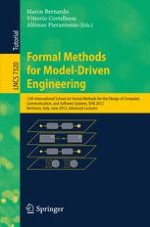2012 | Buch
Formal Methods for Model-Driven Engineering
12th International School on Formal Methods for the Design of Computer, Communication, and Software Systems, SFM 2012, Bertinoro, Italy, June 18-23, 2012. Advanced Lectures
herausgegeben von: Marco Bernardo, Vittorio Cortellessa, Alfonso Pierantonio
Verlag: Springer Berlin Heidelberg
Buchreihe : Lecture Notes in Computer Science
